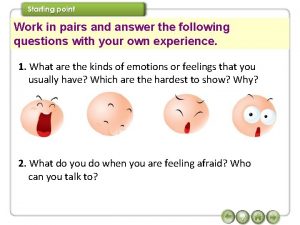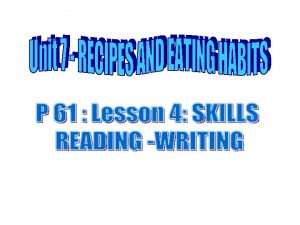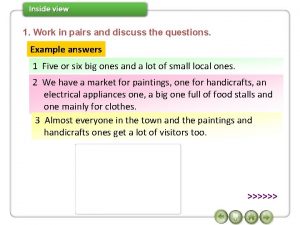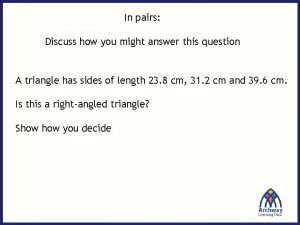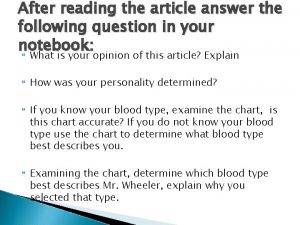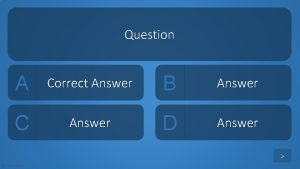I READING Work in pairs Answer the questions











- Slides: 11


I. READING Work in pairs. Answer the questions. 1. What can you see in each picture? 2. Have you ever tried the dishes in the pictures? If so, how did you find them? a bowl of rice different types of sushi miso soup sliced cucumber

* HỌC TỪ VỰNG CÁC EM NHÉ : ( CÁC EM TRA TỪ VÀO TỪ ĐIỂN TRÊN MẠNG ĐỂ TẬP ĐỌC VÀ HỌC THUỘC TỪ VỰNG ) Vocabulary : - typically (adv) điển hình - pickle ( n) Dưa chua/ dưa góp - pickled ( adj) Ngâm chua - staple ( n) Món chính - portion (n) Khẩu phần - characteristic ( adj) Đặc điểm - horseradish (n) Củ cải ngựa - avocado (n) trái bơ - component (n) Thành phần

* Sau khi học từ vựng xong , các em đọc bài báo nói về thói quen ăn uống của người Nhật và làm bài tập 2 và 3 /trang 14

2. The habit of having raw food and simple sauces 3. Components in a typical Japanese meal 1. The art of arranging dishes

3. Read the article again and answer the questions. ( các em tự trả lời sau khi đọc bài báo và sau đó kiểm tra lại đáp án các em nhé. ) 1. What is the most important feature of Japanese eating habits? - They like raw food and do not use sauces with a strong flavour. 2. How do they make sashimi? - They cut fresh fish. 3. What sauce can both sashimi and sushi be served with? - Both can be served with soy sauce. 4. How many components are there in a typical Japanese meal? - There are four (rice, miso soup, main dish(es), pickles). 5. How is rice important in Japanese meals? - Rice is the staple food and is very nutritious. 6. Why do people say that the Japanese eat with their eyes? -Because the dishes are presented in different bowls and plates, and are arranged carefully according to a traditional pattern.

WRITING * Các em nhắn tin hỏi các bạn về thói quen ăn uống và ghi chú lại theo mẫu dưới ( bài tập 4/15). Sau đó các em tiến hành viết về thói quen ăn uống của bạn mình bao gồm thông tin các bữa ăn của bạn mình, ý kiến của em về thói quen ăn uống của bạn. ( Dựa vào gợi ý của cô bên dưới , chú ý thay đổi hình thức của động từ cho phù hợp với thì và chủ ngữ)



Cues given: ( Gợi ý) My friend, ( tên bạn ), /not have / healthy eating habits /. She(he) sometimes / skip/ breakfast. / When she/ have/ it, she(he) usually/ buy/ a hamburger / a soft drink/ a café / our school. For lunch, her(his) favourite /be/ (món ăn). The good thing/be / that she/ prefer/ to have dinner at home/. However, she(he)/ like/ eating a lot of rice/ fatty pork for dinner. She(he) rarely/ eat/ vegetables, but love/ fruits. I think (tên bạn)/ should /change her(his) diet. First, if she(he)/ want/ to have more energy/ the day, she(he)/ should never /skip breakfast. Second, she(he)/ must /reduce the amount of fast food she(he)/ eat/. Also, eating more vegetables would be good for(him) her. She(he) should/ also eat/ less rice for dinner. These changes will definitely keep her(him) fit. (phần chữ đỏ các em có thể thay đổi )

• CHÚC CÁC EM HỌC TỐT ! • (CÓ GÌ CÁC EM LIÊN LẠC CÔ QUA ZALO : 0914242729)
 Answer the questions
Answer the questions Work in pairs to answer the questions
Work in pairs to answer the questions I reading
I reading Work in pairs. discuss the questions.
Work in pairs. discuss the questions. In pairs look at the photo and answer the questions
In pairs look at the photo and answer the questions In pairs look at the photos and answer the questions
In pairs look at the photos and answer the questions Work in pairs discuss the questions
Work in pairs discuss the questions Work in pairs look at the words and answer the questions
Work in pairs look at the words and answer the questions Work in pairs discuss these questions
Work in pairs discuss these questions While reading activities
While reading activities Ab3e2
Ab3e2 What might a person decide to do after reading this article
What might a person decide to do after reading this article

